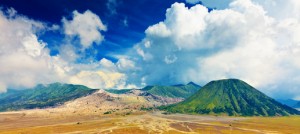By David Olmstead
In planet’s surface or earth crust there are openings or ruptures that allows volcanic ashes, different gases and hot magma to escape are generally known as Volcanoes. Generally when the tectonic plates converges or diverge these volcanic eruptions takes place. different types of volcanoes of volcanoes that can be found in nature are such as composite volcanoes, shield volcanoes, cinder cones, spatter cones and complex volcanoes. Volcanoes can also be classified according to the types of volcanic eruptions.

A composite volcano is also known as strato-volcano because composite strata or layered structure is formed due to the eruptive material. These volcano formations take place due to number of eruptions for several thousand years. These volcanoes are tall and conical in shape and is formed when hot lava escapes through the ruptures or fissures and flows long way. Andesite magma generally forms the composite cones. The main characteristics of the composite volcanoes are periodic and quiet explosion.
Composite volcanoes are generally found in chains along the Pacific Rim and are also called the rim of fire.
Shield volcanoes are entirely formed of the fluid lava. These are large structures and are circular fan shaped in nature and thus look like a shield. Shield volcano formation takes place when pressure formed due to heat of the gas raises the magma upward. The molten lava through the central vent comes out and flows rather than explode upward.
Examples of shield volcanoes Examples of shield volcanoes are the Hawaiian Islands. Here the shield volcanoes are 1600 to 2300 feet high and have a diameter of four to five miles long.
Cinder cone volcano are generally steep sided cones of basalt fragments. Liquid lava blobs are carried by streaming gases in the atmosphere and comes down to earth surface. Ashes, bombs and cinders piles up and the forms the conical vent. Cinders are small pebble sized melted volcanic stones where as bombs are large pieces of rock. Cinder cones are not more the 350 to 500 meter high. The Paricutin in Mexico and the Surter I and Surter II of Iceland are the best example of cinder cone.
Spatter cones are steep sided and low mounds formed of lava fragments that form a linear fissure. As the eruption takes place the molten magma does not cool down completely and forms spatter on the ground. The shapes thus forms are very irregular in nature.
Spatter cones generally consist of highly fluid magma. The Hawaiian island consists of few spatter cones.
Complex volcanoes or compound volcanoes are formed when there is a change in the eruptive nature of the volcano or the main vent area. Strato-volcanoes can also sometimes forms the complex volcanoes since they gets overlapped after repeated eruptions of the volcano, proclastic flows and lava flows and forms multiple vents or summits.
Precambrian rocks of Mexico and the long valley of California are well known complex volcanoes.
Apart from these there are few other types of volcanoes such as super volcanoes, cryptodomes, lava domes, submarine volcanoes. The volcanic emission injects sulphur dioxide, carbon dioxide, water vapor and sulfuric acid in the atmosphere that contributes a lot to acid rain. This is a major effect of volcanic eruption. You can also find types of volcanoes according to activity.
We want pictures and location of the lanforms around the world and we need your help. Click get started button below.
In Asia, China, India, Nepal, and Bhutan are home to one of the eight wonders of the world and one of the most beautiful mountains in the world, the Himalaya Mountains also called the Himalayas. Boasting as the world’s highest and most famous mountain peak, Mt. Everest. Within the verse of the ‘Kumarsambhava’, Sanskrit […]
Nature have provided us with fascinating landforms and features. The most often adored landforms are volcanoes. Like the perfect cone structure of Mayon Volcano in the Philippines or Mount Fiji in Japan, people look at their beauty and wonder with great appreciation to nature. Volcanoes are mountains with a very disastrous nature. Their only […]
Taal Volcano is the second most active volcano found in the province of Batangas. A complex volcano in the middle of Taal Lake and is often called an island within a lake, that is an island within a lake that is on an island as well as one of the lowest volcano in the […]
Mayon Volcano is one of the active volcanoes in the Philippines. Located in the southern part of Luzon about 473 kilometers (294 miles) from Makati Business District of the Philippines, Mount Mayon is the main landmark of the Province of Albay of Bicol Region. According to local folklore, the volcano was named after Daragang […]
The global temperature and weather is to a large extent a direct result of the sun’s effect to our planet. Together with the atmosphere and the rotation of the earth on its axis. The earth on which weather moves on has its own effect on the weather. The different landforms like mountains, volcanoes, plains, and the […]